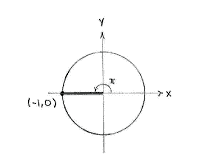Solution 4.2:3c
From Förberedande kurs i matematik 1
m |
|||
| (3 intermediate revisions not shown.) | |||
| Line 1: | Line 1: | ||
| - | + | We can add and subtract multiples of <math>2\pi</math> to or from the argument of the sine function without changing its value. The angle <math>2\pi</math> corresponds to a whole turn in a unit circle and the sine function returns to the same value every time the angle changes by a complete revolution. | |
| - | < | + | |
| - | {{ | + | For example, if we can subtract sufficiently many <math>2\pi</math>'s from <math>9\pi</math>, we will obtain a more manageable argument which lies between <math>0</math> and <math>2\pi\,</math>, |
| - | [[ | + | |
| + | {{Displayed math||<math>\sin 9\pi = \sin (9\pi - 2\pi - 2\pi - 2\pi - 2\pi) = \sin \pi\,\textrm{.}</math>}} | ||
| + | |||
| + | The line which makes an angle <math>\pi</math> with the positive part of the ''x''-axis is the negative part of the ''x''-axis and it cuts the unit circle at the point (-1,0), which is why we can see from the ''y''-coordinate that <math>\sin 9\pi = \sin \pi = 0\,</math>. | ||
| + | |||
| + | [[Image:4_2_3_c.gif|center]] | ||
Current revision
We can add and subtract multiples of \displaystyle 2\pi to or from the argument of the sine function without changing its value. The angle \displaystyle 2\pi corresponds to a whole turn in a unit circle and the sine function returns to the same value every time the angle changes by a complete revolution.
For example, if we can subtract sufficiently many \displaystyle 2\pi's from \displaystyle 9\pi, we will obtain a more manageable argument which lies between \displaystyle 0 and \displaystyle 2\pi\,,
| \displaystyle \sin 9\pi = \sin (9\pi - 2\pi - 2\pi - 2\pi - 2\pi) = \sin \pi\,\textrm{.} |
The line which makes an angle \displaystyle \pi with the positive part of the x-axis is the negative part of the x-axis and it cuts the unit circle at the point (-1,0), which is why we can see from the y-coordinate that \displaystyle \sin 9\pi = \sin \pi = 0\,.

